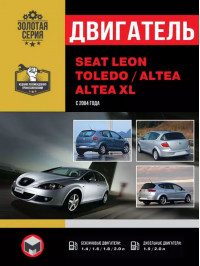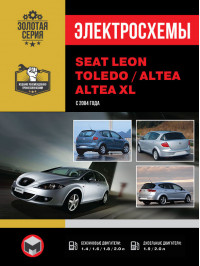Information on repair and maintenance of Seat Toledo cars electronically
Seat Toledo is a model series of lower middle class cars from the Spanish manufacturer Seat, produced from spring 1991 to mid-2009 and from autumn 2012 to autumn 2018. Its name comes from the Spanish city of Toledo, which belongs to Castile-La Mancha. Seat Toledo replaced the Seat Malaga model. It was the first Seat car to be entirely influenced by Volkswagen.
The Seat Toledo is Seat's mid-size sedan with a transverse engine and front-wheel drive. The model was produced in four generations. They all share mechanical and design elements with other Volkswagen Group models.
The first generation Seat Toledo, introduced in 1991, was developed using Volkswagen Golf II and III units. This car, 4.33 meters long, was intended for the lower middle class sedan market and provided a spacious trunk with a capacity of 550 liters.
After the discontinuation of the first generation Seat Toledo, the production line was sold to the Chinese company Chery, which began production of the Chery Fulwin and Chery Amulet models at this base in China in 1999.
The second generation Seat Toledo was presented in 1998 at the Paris Motor Show, and its mass production began in April 1999. This model was already a classic sedan with a small trunk and had the internal designation 1M.
In October 1999, a hatchback version called the Seat Leon was introduced, adding to the company's model line-up. In terms of technical characteristics, the Seat Toledo II was very close to other cars in the Volkswagen group, such as the VW Bora, VW Golf, Audi A3 and Škoda Octavia. The interior of the Seat Toledo II was similar to the Audi A3. However, compared to the previous model, trunk volume has decreased to 500 liters.
The third generation Seat Toledo was introduced in April 2004. The design of the car has been noticeably updated. The range of power engines has become unified with other models of the Volkswagen concern.
The trunk volume in the new Seat Toledo was also 500 liters, remaining at the same level as the previous model. However, the new generation received a higher body, with a height of 1568 mm.
In mid-2009, production of the third generation SEAT Toledo was discontinued.
The fourth generation Seat Toledo was presented in 2012 at the Geneva Motor Show. This car remained a liftback and received proportions reminiscent of the Skoda Octavia. It was 4480 mm long, had a wheelbase of 2600 mm, a width of 1693 mm, and had a trunk capacity of 517 liters. The split rear seatback made it possible to double the trunk volume or more.
The fourth generation Seat Toledo was offered in three trim levels: E (entry level), S (mid-level) and SE (high level).
In 2014, the SEAT Toledo was restyled, resulting in improved LED headlights, an updated multifunction steering wheel, revised interior design and redesigned taillights. These updates made the car more modern and comfortable.
The Seat Toledo was a mid-range family car that offered a combination of comfort, functionality and good handling. Like many other Seat cars, the Toledo provided affordable options for a wide range of buyers.
Having basic car diagnostic and repair skills can be very helpful. Regular inspection and maintenance can extend the life of your vehicle and save you money on expensive trips to the auto repair shop.
On our website you can read, buy and download Seat Toledo repair manuals in PDF format for free, containing information on various aspects of maintenance and repair:
- how to replace the fuel filter yourself;
- how to replace brake discs yourself;
- how to find a malfunction in the car’s lubrication system and fix it;
- What are the main car engine malfunctions and how are they eliminated?
Downloading the Seat Toledo repair manual on your smartphone or tablet is a great idea as it gives you access to the information you need at any time, especially when you are near the car and need urgent advice or repair instructions.
This is a really convenient way to prepare for various situations involving your car and prevent or solve potential problems.





